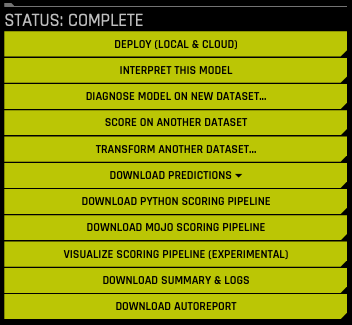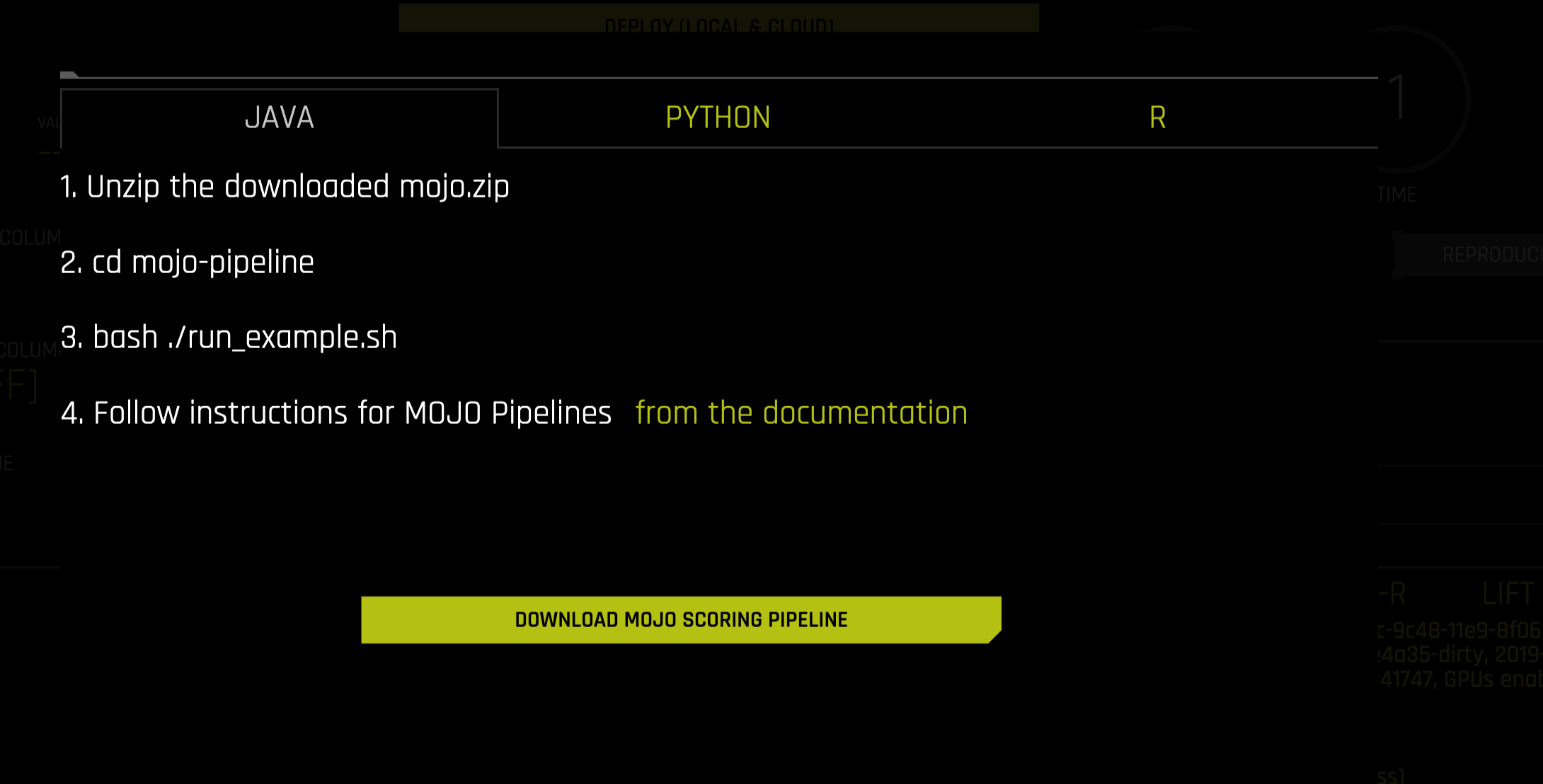Driverless AI MOJO Scoring Pipeline - Java Runtime¶
For completed experiments, Driverless AI automatically converts models to MOJOs (Model Objects, Optimized). The MOJO Scoring Pipeline is a scoring engine that can be deployed in any Java environment for scoring in real time. (Refer to Driverless AI MOJO Scoring Pipeline - C++ Runtime with Python and R Wrappers for information about the C++ scoring runtime with Python and R wrappers.)
Keep in mind that, similar to H2O-3, MOJOs are tied to experiments. Experiments and MOJOs are not automatically upgraded when Driverless AI is upgraded.
Notes:
This scoring pipeline is not currently available for TensorFlow or RuleFit models.
To disable the automatic creation of this scoring pipeline, set the Make MOJO Scoring Pipeline expert setting to Off.
You can have Driverless AI attempt to reduce the size of the MOJO scoring pipeline when it is being built by enabling the Attempt to Reduce the Size of the MOJO expert setting.
Support for Shapley values for ensemble GLM models is currently in beta.
Prerequisites¶
The following are required in order to run the MOJO scoring pipeline.
Java 7 runtime (JDK 1.7) or newer. NOTE: We recommend using Java 11+ due to a bug in Java. (See https://bugs.openjdk.java.net/browse/JDK-8186464.)
Valid Driverless AI license. You can download the
license.sigfile from the machine hosting Driverless AI (usually in the license folder). Copy the license file into the downloadedmojo-pipelinefolder.mojo2-runtime.jar file. This is available from the top navigation menu in the Driverless AI UI and in the downloaded mojo-pipeline.zip file for an experiment.
License Specification¶
Driverless AI requires a license to be specified in order to run the MOJO Scoring Pipeline. The license can be specified in one of the following ways:
Via an environment variable:
DRIVERLESS_AI_LICENSE_FILE: Path to the Driverless AI license file, orDRIVERLESS_AI_LICENSE_KEY: The Driverless AI license key (Base64 encoded string)
Via a system property of JVM (
-Doption):ai.h2o.mojos.runtime.license.file: Path to the Driverless AI license file, orai.h2o.mojos.runtime.license.key: The Driverless AI license key (Base64 encoded string)
Via an application classpath:
The license is loaded from a resource called
/license.sig.The default resource name can be changed via the JVM system property
ai.h2o.mojos.runtime.license.filename.
For example:
# Specify the license via a temporary environment variable
export DRIVERLESS_AI_LICENSE_FILE="path/to/license.sig"
MOJO Scoring Pipeline Files¶
The mojo-pipeline folder includes the following files:
run_example.sh: An bash script to score a sample test set.
pipeline.mojo: Standalone scoring pipeline in MOJO format.
mojo2-runtime.jar: MOJO Java runtime.
example.csv: Sample test set (synthetic, of the correct format).
DOT files: Text files that can be rendered as graphs that provide a visual representation of the MOJO scoring pipeline (can be edited to change the appearance and structure of a rendered graph).
PNG files: Image files that provide a visual representation of the MOJO scoring pipeline.
Quickstart¶
Before running the quickstart examples, be sure that the MOJO scoring pipeline is already downloaded and unzipped:
On the completed Experiment page, click on the Download MOJO Scoring Pipeline button.
In the pop-up menu that appears, click on the Download MOJO Scoring Pipeline button once again to download the scorer.zip file for this experiment onto your local machine. Refer to the provided instructions for Java, Python, or R.
Run the following to score all rows in the sample test set with the file paths to the test set (example.csv), MOJO pipeline (pipeline.mojo) and license (license.sig) stored in environment variables
TEST_SET_FILE,MOJO_PIPELINE_FILE,DRIVERLESS_AI_LICENSE_KEY:
bash run_example.sh
Run the following to score a specific test set (example.csv) with MOJO pipeline (pipeline.mojo) and the license file (license.sig):
bash run_example.sh pipeline.mojo example.csv license.sig
To run the Java application for data transformation directly:
java -Dai.h2o.mojos.runtime.license.file=license.sig -cp mojo2-runtime.jar ai.h2o.mojos.ExecuteMojo pipeline.mojo example.csvNote: For very large models, it may be necessary to increase the memory limit when running the Java application for data transformation. This can be done by specifying
-Xmx25gwhen running the above command.
MOJO Scoring Command-Line Options¶
Executing the Java Runtime¶
The following are two examples of how the Java runtime can be executed from the command-line.
With additional libraries:
java <JVM options> [options...] -cp mojo2-runtime.jar:your-other.jar:many-more-libs.jar ai.h2o.mojos.ExecuteJojo path-to/pipeline.mojo path-to/input.csv path-to/output.csv
Without additional libraries:
java <JVM options> -jar mojo2-runtime.jar path-to/pipeline.mojo path-to/input.csv path-to/output.csv
Note: Data can be streamed from stdin to stdout by replacing both the input and output CSV arguments with `-`.
Supported Options¶
The following is a list of supported options that is displayed when no parameter is given:
-s Set logger to level ERROR (default is WARN)
-v Set logger to level INFO (default is WARN)
-vv Set logger to level DEBUG (default is WARN)
-vvv Set logger to level TRACE (default is WARN)
--[no-]show-predictions
Show model predictions (default: true).
--[no-]show-contributions
Show model contributions (default: false).
-h, --help Show this help message and exit.
-V, --version Print version information and exit.
Note: For more information on controlling logging level, see http://www.slf4j.org/api/org/slf4j/impl/SimpleLogger.html.
Java Virtual Machine (JVM) Options¶
All JVM option names are prefixed with sys.ai.h2o.mojos. This prefix is not included in the following list.
parser.csv.keepCarriageReturn(boolean) - Specify whether to keep the carriage return after parsing. This value defaults to True.parser.csv.stripCrFromLastColumn(boolean) - Workaround for issues relating to the OpenCSV parser. This value defaults to True.parser.csv.quotedHeaders(boolean) - Specify whether to quote header names in the output CSV file. This value defaults to False.parser.csv.separator(char) - Specify the separator used between CSV fields. The special value `TAB` can be used for tab-separated values. This value defaults to `,`.
The following example shows how to change the separator:
java -Dsys.ai.h2o.mojos.parser.csv.separator='|' -Dai.h2o.mojos.runtime.license.file=../license.sig -jar mojo2-runtime.jar pipeline.mojo input.csv output.csv
parser.csv.escapeChar(char) - Specify the escape character for parsing CSV fields. If this value is not specified, then no escaping is attempted. This value defaults to an empty string.parser.csv.batch(int) - Specify the number of input records brought into memory for batch processing (determines consumed memory). This value defaults to 1000.pipelineFormats(string) - When multiple formats are recognized, this option specifies the order in which they are tried. This value defaults to `pbuf,toml,klime,h2o3`.parser.csv.date.formats(string) - Specify a format for dates. This value defaults to an empty string.exposedInputs(string) - Specify a comma separated list of input cols that are needed on output. The special value `ALL` takes all inputs. This defaults to a null value.useWeakHash(boolean) - Specify whether to use WeakHashMap. This is set to False by default. Enabling this setting may improve MOJO loading times.
Execute the MOJO from Java¶
Open a new terminal window, create an experiment folder, and change directories to that new folder:
mkdir experiment && cd experiment
Create your main program in the experiment folder by creating a new file called Main.java (for example, using
vim Main.java). Include the following contents.
import ai.h2o.mojos.runtime.MojoPipeline; import ai.h2o.mojos.runtime.frame.MojoFrame; import ai.h2o.mojos.runtime.frame.MojoFrameBuilder; import ai.h2o.mojos.runtime.frame.MojoRowBuilder; import ai.h2o.mojos.runtime.lic.LicenseException; import ai.h2o.mojos.runtime.utils.CsvWritingBatchHandler; import com.opencsv.CSVWriter; import java.io.BufferedWriter; import java.io.IOException; import java.io.OutputStreamWriter; import java.io.Writer; public class DocsExample { public static void main(String[] args) throws IOException, LicenseException { // Load model and csv final MojoPipeline model = MojoPipeline.loadFrom("pipeline.mojo"); // Get and fill the input columns final MojoFrameBuilder frameBuilder = model.getInputFrameBuilder(); final MojoRowBuilder rowBuilder = frameBuilder.getMojoRowBuilder(); rowBuilder.setValue("AGE", "68"); rowBuilder.setValue("RACE", "2"); rowBuilder.setValue("DCAPS", "2"); rowBuilder.setValue("VOL", "0"); rowBuilder.setValue("GLEASON", "6"); frameBuilder.addRow(rowBuilder); // Create a frame which can be transformed by MOJO pipeline final MojoFrame iframe = frameBuilder.toMojoFrame(); // Transform input frame by MOJO pipeline final MojoFrame oframe = model.transform(iframe); // `MojoFrame.debug()` can be used to view the contents of a Frame // oframe.debug(); // Output prediction as CSV final Writer writer = new BufferedWriter(new OutputStreamWriter(System.out)); final CSVWriter csvWriter = new CSVWriter(writer); CsvWritingBatchHandler.csvWriteFrame(csvWriter, oframe, true); } }
Compile the source code with the files of the MOJO runtime (mojo2-runtime.jar) and MOJO pipeline (pipeline.mojo) copied into the experiment:
javac -cp mojo2-runtime.jar -J-Xms2g -J-XX:MaxPermSize=128m Main.java
Run the MOJO example with the license (license.sig) copied into the experiment:
# Linux and OS X users java -Dai.h2o.mojos.runtime.license.file=license.sig -cp .:mojo2-runtime.jar Main # Windows users java -Dai.h2o.mojos.runtime.license.file=license.sig -cp .;mojo2-runtime.jar Main
The following output is displayed:
CAPSULE.True 0.5442205910902282
Using the MOJO Scoring Pipeline with Spark/Sparkling Water¶
Note: The Driverless AI 1.5 release will be the last release with TOML-based MOJO2. Releases after 1.5 will include protobuf-based MOJO2.
MOJO scoring pipeline artifacts can be used in Spark to deploy predictions in parallel using the Sparkling Water API. This section shows how to load and run predictions on the MOJO scoring pipeline in Spark using Scala and the Python API.
In the event that you upgrade H2O Driverless AI, we have a good news! Sparkling Water is backwards compatible with MOJO versions produced by older Driverless AI versions.
Requirements¶
You must have a Spark cluster with the Sparkling Water JAR file passed to Spark.
To run with PySparkling, you must have the PySparkling zip file.
The H2OContext does not have to be created if you only want to run predictions on MOJOs using Spark. This is because the scoring is independent of the H2O run-time.
Preparing Your Environment¶
In order use the MOJO scoring pipeline, Driverless AI license has to be passed to Spark. This can be achieved via --jars argument of the Spark launcher scripts.
Note: In Local Spark mode, please use --driver-class-path to specify path to the license file.
PySparkling¶
First, start PySpark with PySparkling Python package and Driverless AI license.
./bin/pyspark --jars license.sig --py-files pysparkling.zip
or, you can download official Sparkling Water distribution from H2O Download page. Please follow steps on the Sparkling Water download page. Once you are in the Sparkling Water directory, you can call:
./bin/pysparkling --jars license.sig
At this point, you should have available a PySpark interactive terminal where you can try out predictions. If you would like to productionalize the scoring process, you can use the same configuration, except instead of using ./bin/pyspark, you would use ./bin/spark-submit to submit your job to a cluster.
# First, specify the dependencies
from pysparkling.ml import H2OMOJOPipelineModel, H2OMOJOSettings
# The 'namedMojoOutputColumns' option ensures that the output columns are named properly.
# If you want to use old behavior when all output columns were stored inside an array,
# set it to False. However we strongly encourage users to use True which is defined as a default value.
settings = H2OMOJOSettings(namedMojoOutputColumns = True)
# Load the pipeline. 'settings' is an optional argument. If it's not specified, the default values are used.
mojo = H2OMOJOPipelineModel.createFromMojo("file:///path/to/the/pipeline.mojo", settings)
# Load the data as Spark's Data Frame
dataFrame = spark.read.csv("file:///path/to/the/data.csv", header=True)
# Run the predictions. The predictions contain all the original columns plus the predictions
# added as new columns
predictions = mojo.transform(dataFrame)
# You can easily get the predictions for a desired column using the helper function as
predictions.select(mojo.selectPredictionUDF("AGE")).collect()
Sparkling Water¶
First, start Spark with Sparkling Water Scala assembly and Driverless AI license.
./bin/spark-shell --jars license.sig,sparkling-water-assembly.jar
or, you can download official Sparkling Water distribution from H2O Download page. Please follow steps on the Sparkling Water download page. Once you are in the Sparkling Water directory, you can call:
./bin/sparkling-shell --jars license.sig
At this point, you should have available a Sparkling Water interactive terminal where you can carry out predictions. If you would like to productionalize the scoring process, you can use the same configuration, except instead of using ./bin/spark-shell, you would use ./bin/spark-submit to submit your job to a cluster.
// First, specify the dependencies
import ai.h2o.sparkling.ml.models.{H2OMOJOPipelineModel, H2OMOJOSettings}
// The 'namedMojoOutputColumns' option ensures that the output columns are named properly.
// If you want to use old behavior when all output columns were stored inside an array,
// set it to false. However we strongly encourage users to use true which is defined as a default value.
val settings = H2OMOJOSettings(namedMojoOutputColumns = true)
// Load the pipeline. 'settings' is an optional argument. If it's not specified, the default values are used.
val mojo = H2OMOJOPipelineModel.createFromMojo("file:///path/to/the/pipeline.mojo", settings)
// Load the data as Spark's Data Frame
val dataFrame = spark.read.option("header", "true").csv("file:///path/to/the/data.csv")
// Run the predictions. The predictions contain all the original columns plus the predictions
// added as new columns
val predictions = mojo.transform(dataFrame)
// You can easily get the predictions for desired column using the helper function as follows:
predictions.select(mojo.selectPredictionUDF("AGE")).show()

